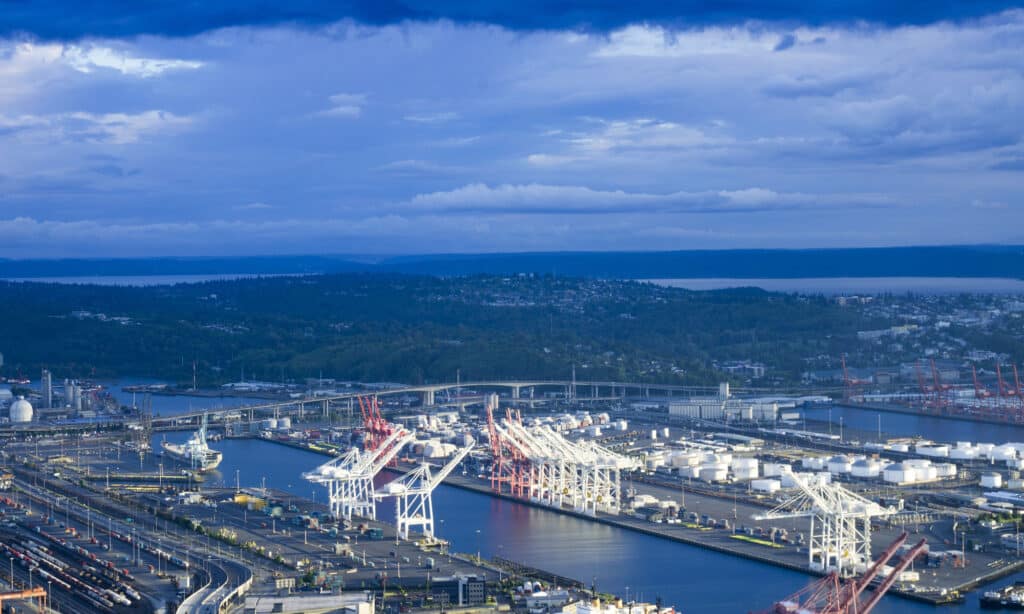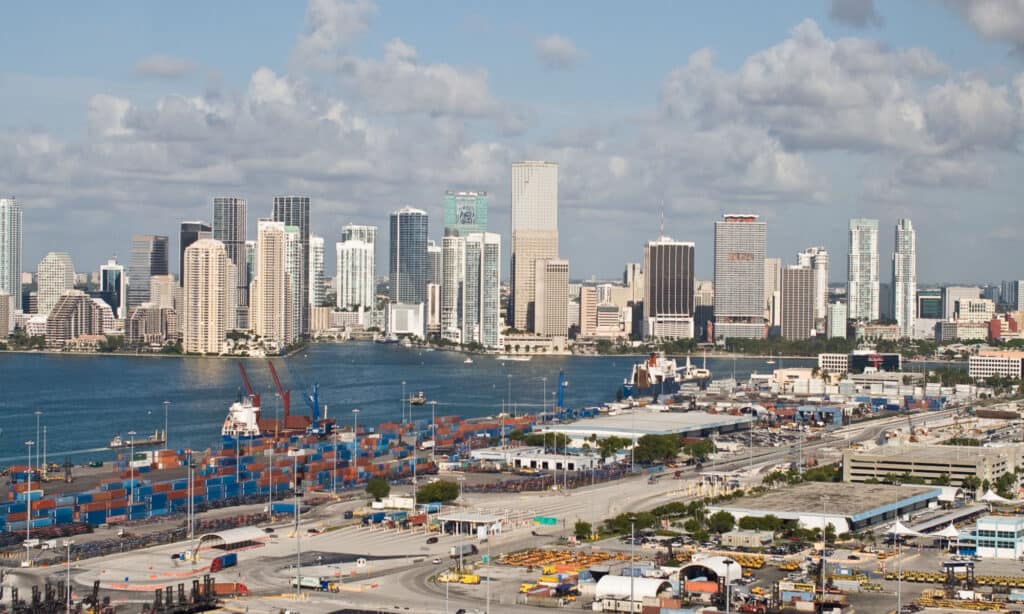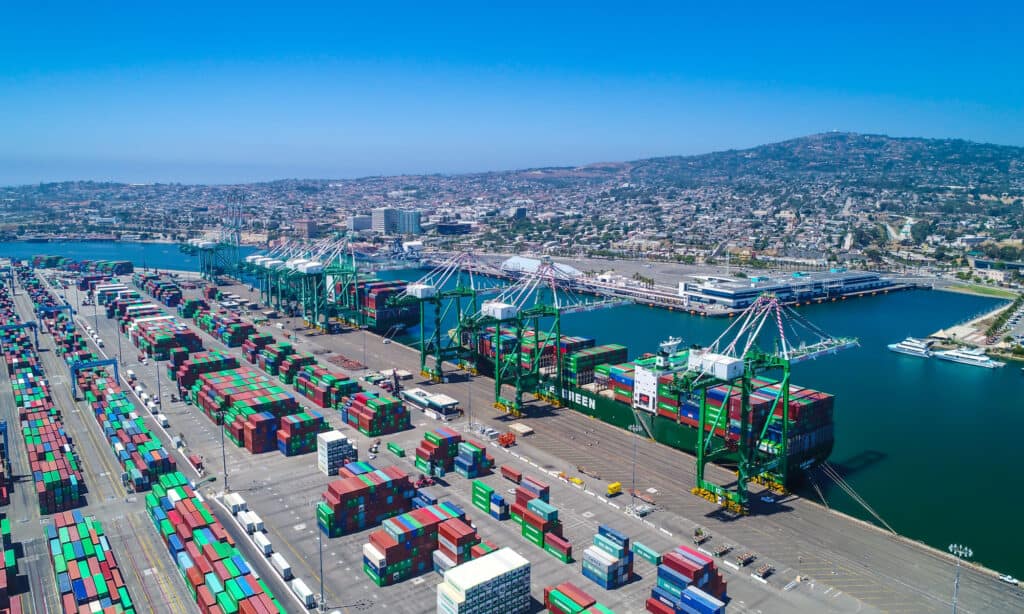The 10 Largest Ports in The U.S.
The vast majority of international trade occurs over the waves of the massive oceans. In fact, about 90% of goods are shipped on the ocean at some point before moving on to the rails and roads. However, that transition between the water and land requires a careful handoff at places called ports. Although the intricacies of trade may seem immaterial to people as they navigate their lives, the constant work performed at ports allows us to maintain our standard of living in the United States. That’s why we’re going to look at the 10 largest ports in the U.S., show you where they’re located, and tell you why each of them is so significant.
What is a Port?

Urban Images/Shutterstock.com
The term “port” has several definitions, so we’re going to disambiguate the term as it pertains to this article. Since we’re primarily interested in trade and not geographical areas or safe havens for ships, we can narrow down the definition a little.
A port is a facility along a body of water where ships load and unload their cargo and passengers. They can be located along the ocean coast or deeper inland. Cargo ships can often traverse large rivers and gain access to major cities built alongside them, cutting down on the need for secondary transit.
Ports typically feature warehouses for storing cargo, heavy machinery to move foods, and customs facilities. Usually, ports are connected to other transit systems that help move cargo into the next part of the supply chain. That means ports often have rails and roads nearby to help move the cargo inland and to its final destinations.
Now that we have a working definition for ports, we can start looking at the largest ones in the U.S.
How Do We Measure the 10 Largest Ports in the U.S.?
Before we start counting down, let’s make one thing clear. We will measure the largest ports in the U.S. according to the number of domestic TEUs they handled. TEU is the twenty-foot equivalent unit that represents a shipping container.
The number of TEUs a port handles is a great indicator of how large and busy it is. Yet, we will also use available data about the amount of cargo that each port moved measured in short tons.
This data comes directly from the Bureau of Transportation Statistics as well as the American Association of Port Authorities.
Unfortunately, the most recent report was published in 2019. A report may be forthcoming in 2022. If and when that happens, we will update this list with the new information. Until then, we will list the most recent data.
We will try to list the size of the port, but that data is a little difficult to come by in some cases. After all, ports don’t always have a clear and distinct starting and stopping area. We will briefly discuss the largest port according to size following this section.
What Are the 10 Largest Ports in the U.S.?

JHPhtography/Shutterstock.com
We’re going to look at the largest ports in the U.S. according to the number of domestic TEUs they processed along with total tonnage. This data should give you a great indication of the total capacity of these facilities.
10. Port of Seattle
| State | TEUs | Tons of Freight |
|---|---|---|
| Washington | 1,293,435 | 23,009,273 |
The Port of Seattle is a large port on the west coast of the United States. This port has an alliance with the Port of Tacoma so that they operate jointly even though the two entities are not merging.
9. Port of Tacoma
| State | TEUs | Tons of Freight |
|---|---|---|
| Washington | 1,662,125 | 21,496,577 |
The busier portion of the Northwest Seaport Alliance, the Port of Tacoma sits on 2,400 acres of land that are used for manufacturing, distributing, shipping, and storage. This port plays a big role in international trade in the Pacific Northwest.
8. Port of Charleston
| State | TEUs | Tons of Freight |
|---|---|---|
| South Carolina | 1,821,148 | 24,596,490 |
This port is located in South Carolina, and it primarily focuses on handling containers, vehicles, and other goods. Some of the port’s facilities handle bulk commodities, too. The Port of Charleston has recently spent millions of dollars to get it ready to receive larger ships to increase its processing amounts.
7. Port of Oakland
| State | TEUs | Tons of Freight |
|---|---|---|
| California | 1,976,338 | 19,349,104 |
The Port of Oakland, despite having the lowest tonnage rate on this list, is a major container ship facility. It is also one of the busiest ports in the U.S. based on the number of containers it processes. This facility has been in operation since 1927!
6. Port of Virginia (Virginia Port Authority)
| State | TEUs | Tons of Freight |
|---|---|---|
| Virginia | 2,172,284 | 61,701,612 |
The Virginia Port Authority operates a large system of facilities in the Hampton, Norfolk, Portsmouth, and Newport areas. This port is large, busy, and continuing to invest in its capabilities. The port is integrating new railroads and increasing traffic in the area.
5. Port of Houston
| State | TEUs | Tons of Freight |
|---|---|---|
| Texas | 2,527,506 | 288,944,468 |
The Port of Houston is located in a major metropolitan area, and it has several major general cargo terminals as well as cargo container terminals. As a result, this port ranks high in terms of the number of containers it processes as well as raw tonnage. In fact, this port had the highest total cargo volume in short tons out of any port in the U.S. in 2019.
4. Port of Savannah
| State | TEUs | Tons of Freight |
|---|---|---|
| Georgia | 3,701,297 | 41,944,446 |
This is another major port on the East Coast of the United States. The Port of Savannah is one of the busiest in the country, and it is also undergoing rapid development. The port is home to many major facilities dedicated to shipping, storage, and inland distribution.
3. Port of New York and New Jersey (Newark)
| State | TEUs | Tons of Freight |
|---|---|---|
| New York and New Jersey | 5,439,059 | 136,575,034 |
The Port of New York and New Jersey straddles the New York-Newark metropolitan area. This is one of the largest ports in the U.S. based on size, freight, and importance. The port is one of the largest natural harbors in the world. This area is greatly stratified with rail systems, airport facilities, and container storage. Furthermore, this port is responsible for a great deal of international trade from Europe.
2. Port of Long Beach
| State | TEUs | Tons of Freight |
|---|---|---|
| California | 5,730,475 | 80,693,406 |
The Port of Long Beach is near Los Angeles. This area is responsible for a great deal of trade coming from Asia. This port was founded in 1911, and it has expanded to become one of the largest, most important ones in the country. Overall, this port processed massive amounts of cargo in 2019 in terms of tonnage and TEUs.
1. Port of Los Angeles
| State | TEUs | Tons of Freight |
|---|---|---|
| California | 6,450,596 | 63,004,373 |
The largest port in the U.S. is the Port of Los Angeles based on its size as well as processed TEUs. This port employs hundreds of thousands of people and takes in massive amounts of cargo from Asia and other places around the world. The amount of processed freight faced some troubles in 2021, but the port is poised to recover its volume.
What Is the Largest Port in the U.S. By Size

Kirk Wester/Shutterstock.com
The largest port by size in the United States is the Port of Los Angeles. This massive facility takes up about 8,000 acres of land, and it is continuing to increase its footprint with its rail systems. Although the Port of Los Angeles does not have the largest amount of cargo processed, it does process the most containers.
More from A-Z Animals
The vast majority of international trade occurs over the waves of the massive oceans. In fact, about 90% of goods are shipped on the ocean at some point before moving on to the rails and roads. However, that transition between the water and land requires a careful handoff at places called ports. Although the intricacies of trade may seem immaterial to people as they navigate their lives, the constant work performed at ports allows us to maintain our standard of living in the United States. That’s why we’re going to look at the 10 largest ports in the U.S., show you where they’re located, and tell you why each of them is so significant.
What is a Port?

Urban Images/Shutterstock.com
The term “port” has several definitions, so we’re going to disambiguate the term as it pertains to this article. Since we’re primarily interested in trade and not geographical areas or safe havens for ships, we can narrow down the definition a little.
A port is a facility along a body of water where ships load and unload their cargo and passengers. They can be located along the ocean coast or deeper inland. Cargo ships can often traverse large rivers and gain access to major cities built alongside them, cutting down on the need for secondary transit.
Ports typically feature warehouses for storing cargo, heavy machinery to move foods, and customs facilities. Usually, ports are connected to other transit systems that help move cargo into the next part of the supply chain. That means ports often have rails and roads nearby to help move the cargo inland and to its final destinations.
Now that we have a working definition for ports, we can start looking at the largest ones in the U.S.
How Do We Measure the 10 Largest Ports in the U.S.?
Before we start counting down, let’s make one thing clear. We will measure the largest ports in the U.S. according to the number of domestic TEUs they handled. TEU is the twenty-foot equivalent unit that represents a shipping container.
The number of TEUs a port handles is a great indicator of how large and busy it is. Yet, we will also use available data about the amount of cargo that each port moved measured in short tons.
This data comes directly from the Bureau of Transportation Statistics as well as the American Association of Port Authorities.
Unfortunately, the most recent report was published in 2019. A report may be forthcoming in 2022. If and when that happens, we will update this list with the new information. Until then, we will list the most recent data.
We will try to list the size of the port, but that data is a little difficult to come by in some cases. After all, ports don’t always have a clear and distinct starting and stopping area. We will briefly discuss the largest port according to size following this section.
What Are the 10 Largest Ports in the U.S.?

JHPhtography/Shutterstock.com
We’re going to look at the largest ports in the U.S. according to the number of domestic TEUs they processed along with total tonnage. This data should give you a great indication of the total capacity of these facilities.
10. Port of Seattle
| State | TEUs | Tons of Freight |
|---|---|---|
| Washington | 1,293,435 | 23,009,273 |
The Port of Seattle is a large port on the west coast of the United States. This port has an alliance with the Port of Tacoma so that they operate jointly even though the two entities are not merging.
9. Port of Tacoma
| State | TEUs | Tons of Freight |
|---|---|---|
| Washington | 1,662,125 | 21,496,577 |
The busier portion of the Northwest Seaport Alliance, the Port of Tacoma sits on 2,400 acres of land that are used for manufacturing, distributing, shipping, and storage. This port plays a big role in international trade in the Pacific Northwest.
8. Port of Charleston
| State | TEUs | Tons of Freight |
|---|---|---|
| South Carolina | 1,821,148 | 24,596,490 |
This port is located in South Carolina, and it primarily focuses on handling containers, vehicles, and other goods. Some of the port’s facilities handle bulk commodities, too. The Port of Charleston has recently spent millions of dollars to get it ready to receive larger ships to increase its processing amounts.
7. Port of Oakland
| State | TEUs | Tons of Freight |
|---|---|---|
| California | 1,976,338 | 19,349,104 |
The Port of Oakland, despite having the lowest tonnage rate on this list, is a major container ship facility. It is also one of the busiest ports in the U.S. based on the number of containers it processes. This facility has been in operation since 1927!
6. Port of Virginia (Virginia Port Authority)
| State | TEUs | Tons of Freight |
|---|---|---|
| Virginia | 2,172,284 | 61,701,612 |
The Virginia Port Authority operates a large system of facilities in the Hampton, Norfolk, Portsmouth, and Newport areas. This port is large, busy, and continuing to invest in its capabilities. The port is integrating new railroads and increasing traffic in the area.
5. Port of Houston
| State | TEUs | Tons of Freight |
|---|---|---|
| Texas | 2,527,506 | 288,944,468 |
The Port of Houston is located in a major metropolitan area, and it has several major general cargo terminals as well as cargo container terminals. As a result, this port ranks high in terms of the number of containers it processes as well as raw tonnage. In fact, this port had the highest total cargo volume in short tons out of any port in the U.S. in 2019.
4. Port of Savannah
| State | TEUs | Tons of Freight |
|---|---|---|
| Georgia | 3,701,297 | 41,944,446 |
This is another major port on the East Coast of the United States. The Port of Savannah is one of the busiest in the country, and it is also undergoing rapid development. The port is home to many major facilities dedicated to shipping, storage, and inland distribution.
3. Port of New York and New Jersey (Newark)
| State | TEUs | Tons of Freight |
|---|---|---|
| New York and New Jersey | 5,439,059 | 136,575,034 |
The Port of New York and New Jersey straddles the New York-Newark metropolitan area. This is one of the largest ports in the U.S. based on size, freight, and importance. The port is one of the largest natural harbors in the world. This area is greatly stratified with rail systems, airport facilities, and container storage. Furthermore, this port is responsible for a great deal of international trade from Europe.
2. Port of Long Beach
| State | TEUs | Tons of Freight |
|---|---|---|
| California | 5,730,475 | 80,693,406 |
The Port of Long Beach is near Los Angeles. This area is responsible for a great deal of trade coming from Asia. This port was founded in 1911, and it has expanded to become one of the largest, most important ones in the country. Overall, this port processed massive amounts of cargo in 2019 in terms of tonnage and TEUs.
1. Port of Los Angeles
| State | TEUs | Tons of Freight |
|---|---|---|
| California | 6,450,596 | 63,004,373 |
The largest port in the U.S. is the Port of Los Angeles based on its size as well as processed TEUs. This port employs hundreds of thousands of people and takes in massive amounts of cargo from Asia and other places around the world. The amount of processed freight faced some troubles in 2021, but the port is poised to recover its volume.
What Is the Largest Port in the U.S. By Size

Kirk Wester/Shutterstock.com
The largest port by size in the United States is the Port of Los Angeles. This massive facility takes up about 8,000 acres of land, and it is continuing to increase its footprint with its rail systems. Although the Port of Los Angeles does not have the largest amount of cargo processed, it does process the most containers.






